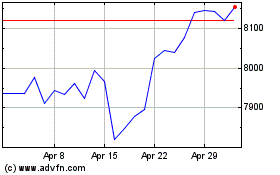By Max Bernhard and Paul Vigna
The Dow Jones Industrial Average slumped more than 500 points
Wednesday as the latest private-sector jobs report added to
concerns about a slowdown in the U.S. economy.
Worries about slowing global growth resumed this week after the
Institute for Supply Management said Monday that its U.S.
manufacturing index fell in September to the lowest level since
June 2009.
"It feels like one thing after another the last couple of days,"
said David Laffertry, chief market strategist at Natixis. While the
ADP report was soft rather than outright weak, he said, "within the
context of other bad macro data the last couple of days, it's sort
of piling on."
Wednesday's declines were broad and accelerated through the
morning. All 11 sectors in the S&P 500 dropped, as did 28 of
the 30 blue-chip stocks in the Dow. Among the biggest losers were
shares of big industrial and technology companies.
Delta Air Lines dropped nearly 7%, while aluminum parts
manufacturer Arconic fell 4%. Apple and Google both tumbled more
than 2%.
The Dow industrials fell 511 points, or 1.9%. The S&P 500
dropped 1.8% and the Nasdaq Composite lost 1.7%.
With Wednesday's slide, the S&P 500 is in danger of falling
more than 1% in consecutive sessions for the first time this year.
The last time the broad equity gauge dropped that much on
back-to-back days was Dec. 24, 2018, when an end-of-year selloff
nearly ended the long-running bull market.
The picture of a broadly weaker economy being drawn by the data,
as well as all the geopolitical news, is a gut-check for investors,
said Shawn Synder, the head of investment strategy at Citi Personal
Wealth Management.
"You've got protests in Hong Kong, impeachment, weak ISM
numbers, you combine it all together and say, okay, it's time to
de-risk a little bit, " he said.
The ADP National Employment Report on Wednesday beat muted
expectations -- the private sector added 135,000 jobs in September,
above expectations. But the firm cut its August estimate by nearly
40,000, and the three-month average of 145,000 is down from 214,000
a year ago.
Altogether, it was the latest sign that businesses are turning
more cautious in the face of a weakening global economy.
If the manufacturing slowdown spreads to the still robust
service sector, this would increase pressure on the Federal Reserve
to cut rates again in October, said Stefan Schilbe, HSBC Germany's
chief economist. The Institute for Supply Management's services
sector report is due Thursday.
The market odds of a Fed rate cut in October rose to 72%
Wednesday morning, up from 53% a week ago, according to data from
CME's FedWatch tracker.
Two economic reports later this week that focus more on the
consumer, the ISM's services sector report and Friday's payrolls
report, now take on a heightened importance, Citi's Mr. Snyder
said. "So far the consumer has been the silver living holding
everything together," he said.
Markets overseas continued to react to disappointing economic
data. The Stoxx Europe 600 was down 2.6%, with Germany's DAX 2.4%
lower and the U.K.'s FTSE 100 down 3.3%.
Germany's leading economics research institutes jointly lowered
their growth forecasts Wednesday for Europe's largest economy. They
cited slowing global demand for capital goods, structural changes
in the auto sector -- one of Germany's most important industries --
and political uncertainty.
"You've got Trump flattening, Warren surging, and Johnson
threatening," Natixis's Mr. Lafferty said. "You've got this wet
blanket of geopolitical overhang in a market that's already
struggling."
In Asia, South Korea's Kospi was down nearly 2% following news
that North Korea fired at least one missile off its east coast. The
move, seen as a show of strength, came after Pyongyang said it
would resume official nuclear talks with the U.S.
In Japan, the Nikkei fell 0.5% and Hong Kong's Hang Seng was
down 0.2%. Mainland Chinese stock markets were closed for a
holiday.
In commodities, WTI crude fell 2.2% to $52.47 a barrel.
The yield on U.S. 10-year Treasurys was lower at 1.597%, from
1.638% Tuesday. Bond yields and prices move in opposite
directions.
Write to Max Bernhard at Max.Bernhard@dowjones.com and Paul
Vigna at paul.vigna@wsj.com
(END) Dow Jones Newswires
October 02, 2019 11:57 ET (15:57 GMT)
Copyright (c) 2019 Dow Jones & Company, Inc.
FTSE 100
Index Chart
From Jun 2024 to Jul 2024

FTSE 100
Index Chart
From Jul 2023 to Jul 2024
